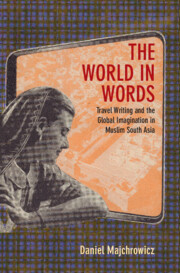2 - A Future Fit for a King
Published online by Cambridge University Press: 28 February 2023
Summary
Sair al-Muhtasham (The travels of al-Muhtasham, 1852) by Ghaus Muhammad Khan, Nawab of Jaora, was among the earliest Urdu travelogues and just the second full-length account written in Urdu by an Indian court. Its publication helped inaugurate a tradition of princely travel writing that would sweep the subcontinent. Precolonial rulers had shown little interest in the genre, but the politics of sovereignty in nineteenth-century India made the travelogue appealing to “princes” like Ghaus Muhammad. He and his fellow Indian rulers were tightly bound by treaties with the British that limited their ability to command their armies, control their finances, or regulate their foreign relations. These limitations forced them to find new ways to assert legitimacy and project their continued relevance. Travel literature let them present themselves as competent actors, and as legitimate, efficient, and just rulers with an irreplaceable role. Through it, they even aspired to augment their status in a colonial system designed to control, minimize, or terminate indigenous rule.
When Ghaus Muhammad wrote Sair al-Muhtasham in 1852, princely travel writing hardly existed, and no sitting Indian ruler had ever left the subcontinent. Nor had precolonial rulers claimed princely travel benefited the populace. By the late nineteenth century, though, India’s indigenous rulers were constantly on the move, traveling and writing, they said, in the service of their subjects. They were such frequent travelers that they regularly encountered one another at hotels and on steamer decks. The Nawab of Basoda wrote at least nine book-length accounts in Urdu chronicling his many travels around the world, from China to Morocco. Jagatjit Singh of Kapurthala published five accounts in multiple languages on Cuba, Java, and Brazil, among other destinations. The queens of Bhopal maintained a nearly century-long tradition of princely travel writing that began in 1863.
One of the wealthiest and most prolific traveling princes was Nawab Hamid ‘Ali Khan (1875–1930) of Rampur. By the age of seventeen, Hamid ‘Ali had seen and written about much of the world, including such distant places as Sitka in the Alaskan panhandle. Throughout that trip—part of a world tour (Figure 2.2)—he had had his scribe note down his observations for publication in a two-volume travelogue, Masir-i Hamidi (The voyages of Hamid, 1893).
- Type
- Chapter
- Information
- The World in WordsTravel Writing and the Global Imagination in Muslim South Asia, pp. 78 - 106Publisher: Cambridge University PressPrint publication year: 2023



